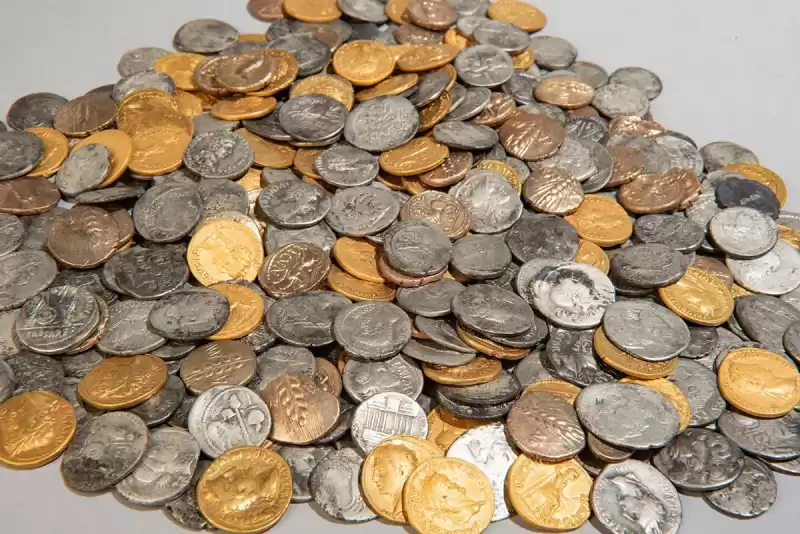 |
|
 |
|
 |
|
 |
|
 |
|
 |
|
 |
|
 |
|
 |
|
 |
|
 |
|
 |
|
 |
|
 |
|
 |
|
In 2023, two metal detectorists unearthed a remarkably extensive and diverse haul of coins from the first century C.E. Their find—a collection of 404 gold and silver coins of Roman, British and North African origin—is the first of its kind unearthed on the European continent.

Two Dutch metal detectorists have unearthed a massive hoard of 404 gold and silver coins from the first century C.E. in the Netherlands, marking the first discovery of its kind on the European continent, according to a statement from the National Museum of Antiquities.
Discovered in 2023, the coins were found in the muddy fields of Bunnik, a village in Utrecht Province that once marked the northern edge of the Roman Empire. The stash includes 360 Roman coins, two coins from the North African kingdom of Numidia, and 44 staters from Celtic Britain.
While searching for a local fruit grower's lost tractor key in Houten, Gert-Jan Messelaar and Reinier Koelink decided to give up and head over to a nearby field in Bunnik, where they had previously found a few coins, reports RTV Utrecht’s Bas Teunissen.
Koelink made the first find: a golden Celtic coin resting near the surface of the mud. The pair found a few more loose coins—including the largest Roman coin ever found in the province—but their metal detectors would not stop beeping. Messelaar finally stuck his hand into a shallow hole in the ground, where he uncovered a stash of hundreds of coins. “Bingo,” he recalls thinking, according to RTV Utrecht.
Koelink and Messelaar used clumps of mud to keep the coins together before bringing the haul back home, where they carefully cleaned, sorted and reported their findings to cultural heritage authorities. Then, they celebrated.
“We opened a bottle of champagne,” Messelaar tells the Guardian’s Daniel Boffey. “You never find this.”
Following the detectorists’ initial discovery of 381 coins in the summer, the Dutch Cultural Heritage Agency, with the help of Koelink and Messelaar, conducted additional excavations in the surrounding areas, finding another 23 coins.
Now, the grand total of 404 coins will join a permanent exhibition titled “The Netherlands in Roman Times” at the National Museum of Antiquities in Leiden later this year.
Dated to between 200 B.C.E. and 47 C.E., 360 of the coins are Roman in origin. Of these, 288 are denarii, the standard silver coin, and 72 are aurei, a denser, golden coin that was originally worth 25 denarii.
Many of the Roman coins bear the portrait of Emperor Claudius, who reigned between 41 and 54 C.E. One depicts Julius Caesar, while another even rarer coin shows the likeness of Juba, the ruler of Numidia, a kingdom in northern Africa that roughly corresponds to modern-day Algeria.
Two of the Claudius coins dated to between 46 and 47 C.E. are from identical dies, suggesting they were distributed to Roman soldiers as military pay, write Anton Cruysheer, an archaeologist with the Utrecht Landscape and Heritage Foundation, and Tessa de Groot, an archaeologist with the Cultural Heritage Agency of the Netherlands, for UtrechtAltijd.
The 44 non-Roman coins are perhaps the most notable of the entire stash. The golden alloy coins, known as staters, bear the inscription “CVNO,” the first four letters of Cunobelinus, the Latin name of Celtic King Cunobelin, who reigned between roughly 10 and 42 C.E. in southeastern Britain.
Cruysheer and de Groot argue that the eclectic composition of the hoard “strongly suggests a connection to the conquest of Britain” under Aulus Plautius, a Roman general who Claudius dispatched to cross the Channel and invade the island in 43 C.E.
The wide range of dates of the Cunobelin staters, including four posthumously issued coins, indicates that the stash was removed from circulation in one fell swoop, like Roman troops looting the newly conquered territory, according to UtrechtAltijd.
Combined with the Roman coins used as military pay, the entire stash strongly resembles spoils of war. Discovered less than a foot beneath the surface, where it was probably buried in a leather pouch that has since decayed, the cache was left in a region where Roman troops were known to have amassed before the invasion of Britain.
“This is the first time that physical evidence of the return of the troops has been found,” Cruysheer tells the Guardian. “Apparently, they came back with all sorts of things. That is new information.”
Disclaimer:info@kdj.com
The information provided is not trading advice. kdj.com does not assume any responsibility for any investments made based on the information provided in this article. Cryptocurrencies are highly volatile and it is highly recommended that you invest with caution after thorough research!
If you believe that the content used on this website infringes your copyright, please contact us immediately (info@kdj.com) and we will delete it promptly.
-

- "Cardano (ADA) Price Could Dip Below $0.60, Following Previous Market Cycle"
- Apr 09, 2025 at 05:10 am
- "Cowen goes on to say that ADA's technical indicators, such as its 20-week simple moving average (SMA) and 21-week exponential moving average (EMA), are lining up with the theory that the crypto asset could see another sizeable dip."
-

- BONK, the well-known meme coin, has risen over 35% in the last week, attracting meme coin investors in the market. So, what caused this rally?
- Apr 09, 2025 at 05:10 am
- The well-known meme coin, BONK, has risen over 35% in the last week, attracting meme coin investors in the market. So, what caused this rally?
-

-

-

-

-

-

-


























































